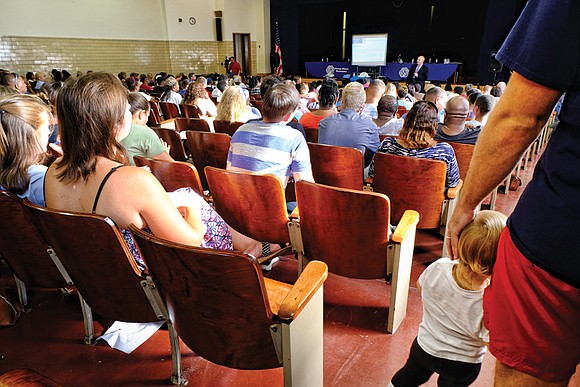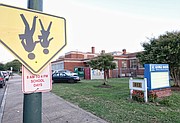Fate of East End school on hold
8/4/2017, 7:55 a.m.

By Holly Rodriguez
When students, teachers, staff and administrators walk into George Mason Elementary School, two welcome mats greet them, each bearing the school’s name. The first one says “Expect the Best,” and the second says “Moving from Good To Great.”
Both messages are a sharp contrast to the conditions facing students and staff beyond the front doors, as parents, educators, alumni and area residents passionately expressed to the Richmond School Board on Monday night.
At a community forum held at the school once attended by Richmond native L. Douglas Wilder, the first African-American elected governor in the United States, people described foul conditions including live and dead mice, the daily cleanup of vermin droppings, roaches, leaking pipes causing ceiling tiles to cave in, the pungent stench of urine from leaking bathrooms permeating hallways and classrooms, students wearing coats in the winter to keep warm and being moved out of classrooms in the spring because of intense heat.
The purpose of the forum was to get community feedback on eight options the School Board outlined to address and resolve chronic problems at the school at 813 N. 28th St. in the East End.
Despite these complaints, and student and teacher reports about health issues ranging from headaches to asthma, interim Superintendent Tommy Kranz repeatedly has said the building is safe. In a presentation to the auditorium packed with nearly 200 people, Mr. Kranz said air quality tests in November and July showed that the building is safe.
Several speakers, sharing their frustration, said there is a difference between safety and an environment conducive to learning.
Hope Talley, a fourth-grade teacher at George Mason, wears a mask to protect her from allergy flareups that are aggravated by conditions at the school that was built more than a century ago.
“If I don’t wear my mask, I get severe sinus headaches, nose drainage and I’m in the bed for two days, minimum,” she said.
Ms. Talley said the stench from decaying vermin trapped in her classroom walls forced her class to move to a computer lab for two weeks during preparations for Standards of Learning tests.
Ms. Talley, who began teaching at the school in 2006 after working as a paralegal in Washington for nearly 20 years, said acute problems at George Mason have been remedied with temporary patchwork repairs.
“Our children deserve better. Expensive Band-Aids across the district are not a solution,” Ms. Talley told School Board members. “We need you to have a plan.”
Mr. Kranz said repairs to the school have been on the district’s radar for years, but plans have been stifled by lack of money.
“Dating back to 1995, there have been recommendations to build a new George Mason Elementary School and it has remained at the top of the capital projects list ever since,” he told the Free Press in an email on Tuesday. “Unfortunately, this has not happened due to limited capital funding resources and a prior decision to redirect the monies by our funding body.”
George Mason is the proverbial canary in the mine, as two-thirds of the city’s public school buildings are more than 50 years old and many are in disrepair, according to Mr. Kranz.
On Monday, Mr. Kranz offered a suggestion — a $6 million bond to install a new heating and air conditioning system, replace all of the school’s windows and doors and possibly renovate the restrooms.
Ms. Talley said the proposal is another expensive Band-Aid that will not solve the problem. A new school building is needed, she said.
Her sentiment was echoed by E. Martin “Marty” Jewell, a former member of Richmond City Council and advocate for the city schools.
“The only real answer is to build a new school,” he told the board at the meeting. “And don’t tell me we don’t have the money. We’re not lacking money. We are lacking in moral judgment. You can’t do this to children and expect to be respected.”
School Board member Jonathan Young, 4th District, attempted to make a motion to have the students, teachers and staff moved from George Mason to Franklin Military Academy before the 2017-18 school year starts on Sept. 5. Franklin students, in turn, would be moved to join students at Richmond Community High School.
But board Chairwoman Dawn Page shut down the motion, saying the purpose of Monday’s meeting was solely to hear from the public. She said a vote will be taken during the board’s meeting on Monday, Aug. 7.
Mr. Young told the Free Press on Tuesday he felt a sense of urgency and that the board needed to take immediate action.
“It’s just unacceptable for kids to go to school under these conditions,” he said. He added that not voting presents an inconvenience for people who may not be able to come to the next School Board meeting.
“Anybody who has come out for two hours, listening to one speaker after another … to have the meeting adjourn with no action is a little disheartening.”
Ms. Page told the Free Press via email that five different plans recommending repairs at all of the schools and their estimated cost have been prepared during the past 15 years for the School Board at a substantial cost to taxpayers.
But recent intervention at RPS by the Virginia Department of Education may be the game changer for George Mason Elementary and all city schools. A recent memorandum of understanding signed by RPS and the state pushes the school district to take the next step, she said.
“The recent review of the memorandum of understanding indicated that the school district has developed construction plans, but a corrective action plan requires the city to develop a funding plan,” Ms. Page said. “The School Board, City Council, mayor, and the city must continue to work collaboratively to ensure that we are committed to creating a funding plan and taking action now.”









